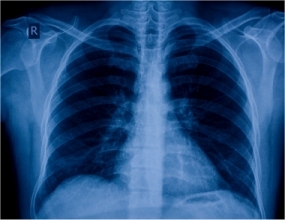What is Malignant Mesothelioma?
Mesothelioma is often considered the most devastating of the asbestos-related diseases as there is no cure and most victims are not alive 1-2 years after diagnosis.
Malignant mesothelioma is a cancer arising from the mesothelial cells that are found in the protective lining, the mesothelium, that covers many of the body's organs. When a person inhales asbestos, the particles can pass through the body and may lodge in one of the mesothelium for many years before cancerous cells begin to grow.
People are usually diagnosed with malignant mesothelioma between the ages of 50 to 70 with the disease being more prevalent in men. 90% of all cases of the disease are caused by the inhalation of asbetos fibres.

Malignant mesothelioma is the most sinister form of asbestos related diseases, the risk of developing it varies with the type of industry in which the exposure occurred and with the extent of the exposure to asbestos.
Not all workers exposed to asbestos will develop asbestos-related diseases.
There are different types of mesothelioma cancer depending on location in the body. The most common type is Pleural Mesothelioma which is a tumor of the lining surrounding the lungs.
Other less common forms of the cancer are:
Peritoneal Mesothelioma, affecting the lining of the abdominal cavity, and Pericardial Mesothelioma, affecting the lining of the heart.
What is Pleural Mesothelioma?
The mesothelium covering the lungs is called the pleura and consists of two layers. The gap between the two layers (the pleural space) is filled with a lubricating fluid that assists the lungs to move smoothly during the breathing cycle.
The most common type of the disease arises in the pleura and is called Pleural Mesothelioma and affects around 75% of the people who are diagnosed with the disease.
What is Peritoneal Mesothelioma?
Peritoneal Mesothelioma occurs in the abdominal lining, which secretes fluids to allow organs to move smoothly and helps to protect the digestive system. Mesothelioma Cancer replaces healthy cells in the peritoneum with cancerous ones, causing a swelling of the abdomen and damage to the digestive system.
Peritoneal Mesothelioma is the second most common form of Mesothelioma Cancer. Diagnostically it is more prevalent in males than in females. The only known cause of Peritoneal Mesothelioma is exposure to asbestos. The latency period of the condition is approximately 20 – 30 years after exposure to asbestos, shorter than that of Pleural Mesothelioma.
Click to read more about Peritoneal Mesothelioma >
What is Pericardial Mesothelioma?
Pericardial Mesothelioma is the rarest form of the disease and accounts for approximately 10% of all incidences per annum. As with the other Mesothelioma conditions, typical pericardial mesothelioma symptoms can often be mistaken and misdiagnosed for something more familiar. For example symptoms such as shortness of breath, persistent chest pain and palpitations, extreme fatigue can typify those of a heart attack.
Pericardial mesothelioma, as the name suggests, affects the lining that surrounds the heart and is associated with long term exposure to asbestos fibres. The symptoms of pericardial mesothelioma, as with other types of mesothelioma, can take many years to manifest.
Click to read more about Pericardial Mesothelioma >
What is Mesothelioma of the Reproductive Organs?
There are also Mesothelial membranes surrounding the reproductive organs. In men, this is the called the Tunica Vaginalis Testis, the tissue covering the testes. In women, the Tunica Serosa Uteri, the tissue covering the ovaries. Mesothelioma can develop in these areas, though this is a very rare cancer, with only around 100 reported cases.
Related Pages . . .
Signs and Symptoms of Mesothelioma
Treatment options for Mesothelioma













